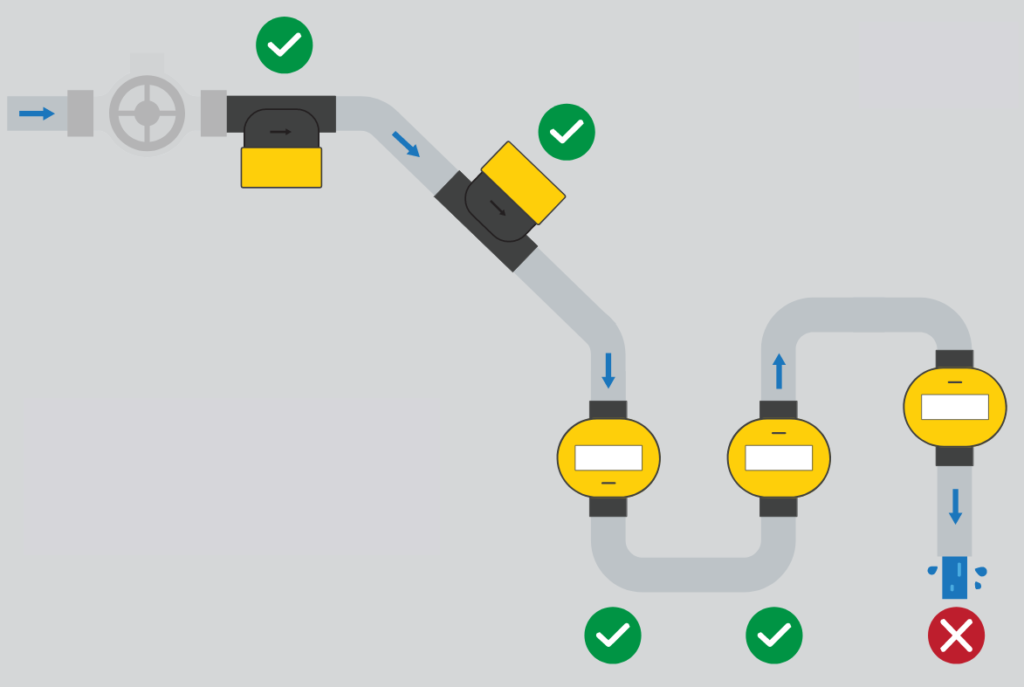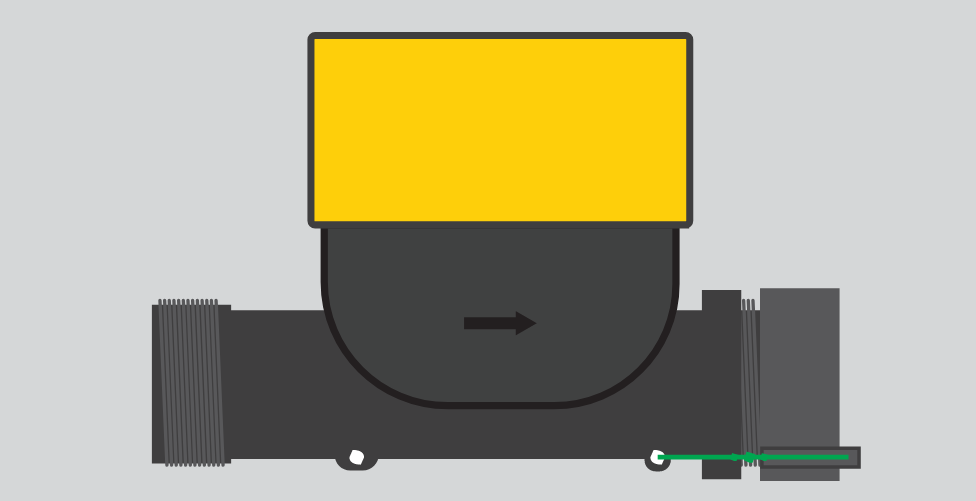Do ultrasonic water meters need to be installed horizontally?

What is a smart metering system?
2024-03-08
What is Non-Revenue Water and How to Reduce it?
2024-03-22Ultrasonic water meter stand out among technologies driving the smart water revolution due to their accuracy and minimal impact on water flow. Unlike traditional mechanical meters, which have moving parts, ultrasonic meters use high-frequency sound waves to measure water velocity within pipes. Given the frequent inquiries about ultrasonic water meters, we’ve created this Q&A list to address the most common questions.
Do ultrasonic water meters need to be installed horizontally?
It might surprise you, but you can mount ultrasonic water meters in any way. Unlike traditional mechanical water meters, which may have specific orientation requirements due to the mechanics involved. Whether installed horizontally or vertically, ultrasonic flow meters deliver accurate and reliable measurements. The key factor to consider is the alignment of the meter’s sensor with the direction of water flow. This alignment ensures optimal performance and precise measurement accuracy. Whether mounted horizontally along a wall or vertically within a piping system, ultrasonic water meters adapt seamlessly.
This flexibility in orientation is a testament to the advanced technology and engineering behind ultrasonic water meters. It offers greater convenience and versatility for installers, allowing them to accommodate different plumbing configurations with ease. Ultrasonic water meters meet diverse water management needs in residential, commercial, and industrial settings.

Where is the best place to put an ultrasonic water meter?
Determining the optimal placement for an ultrasonic water meter involves several considerations to ensure accurate measurement and efficient operation. The ideal location for installing an ultrasonic water meter depends on a few factors:
One of the primary considerations when determining the best placement for an ultrasonic water meter is accessibility. The meter should be easy to access for maintenance and servicing. Opt for a location that allows for quick and convenient inspections, as well as any necessary repairs. This minimizes disruptions and downtime, keeping your water meter running smoothly.
Another Key factor is Network and Connectivity. Consider the communication networks used by the smart water meter to transmit readings and alerts. Ensure that you place the meter in an area where it can easily connect to these networks. For example, if you enclose it in a thick metal box, it may struggle to communicate wirelessly with LoRaWAN, NB-IoT, or cellular.
Flow Dynamics: Take into account how water flows through the pipes in your plumbing system. Choose a location where the flow is consistent and around 0.3 bar to ensure accurate measurement. If you’re planning to use a W1 ultrasonic water meter, ensure that you align water pipes on the same axis. Misalignment of the axles of the pipes poses a huge risk of lateral stress and breaking the meter. Either instantly or afterward. In a case where aligning the axles of the pipes is not easily available, a simple recommendation is to use flexible pipe connectors.
Consider the environmental factors that may impact the meter’s operation. Ensure that the chosen location protects the meter from extreme temperatures and potential damage from external elements. This helps preserve the integrity of the meter and maintains accurate readings over time. It’s worth noting that W1 ultrasonic water meters boast waterproof capabilities, boasting an IP68 rating. This designation ensures that the meter is resilient against water ingress, enabling you to safely place it in flood-prone areas like outdoor environments or pits.
What size is a standard home ultrasonic water meter?
A standard home water meter typically falls within the range of 5/8″ to 3/4″ in size.
These sizes are commonly in use for residential properties, including single-family homes. Although single-family residences less frequently use larger sizes such as 1″, 1.5″, and 2″, they are typically found in commercial or industrial settings. Manufacturers often indicate the size of the water meter on the meter face or stamp it into the case, providing clarity for homeowners and plumbers when determining the appropriate size for a specific application. If you’re looking for an ultrasonic water meter for your next project, consider taking a look at the W1 ¾” or 1” ultrasonic water meters.
What is the direction of flow of the ultrasonic water meter?

Water flows through a water meter from the inlet side to the outlet side, meaning that it enters through one side, passes through the meter, and exits from the other side. Typically, there is an arrow on the side of the meter indicating the direction of water flow.
What is the most accurate water meter?
The most accurate water meter is generally considered to be the ultrasonic water meter. Utilizing ultrasound technology, ultrasonic meters precisely measure the speed of the fluid, providing property owners and managers with real-time and highly accurate data recording. This technological advancement not only helps prevent billing disputes but also ensures long-term reliability due to the absence of moving parts. Ultrasonic meters come in two types: transit time ultrasonic flow meters and Doppler ultrasonic flow meters, each offering unique advantages for various applications. Overall, people regard ultrasonic water meters for their unmatched accuracy and reliability in measuring water flow.
What are the disadvantages of water meters?
Although extremely useful for precisely calculating water consumption, water meters do have certain drawbacks. One drawback is the possibility of inaccuracy, especially if the meter is not well-calibrated or maintained. Furthermore, with time, wear and tear from moving elements in mechanical meters can result in decreasing accuracy and even failure. The initial expense of buying and installing the meter, which may be a sizable expenditure for businesses or homeowners, is another disadvantage. Additionally, certain meters could be vulnerable to problems like blockages or harm from outside elements like freezing temperatures or physical manipulation. Ultimately, regular inspection and maintenance of water meters may increase the expense and difficulty of controlling water usage.
Conclusion
To sum up, ultrasonic water meters, with their unmatched accuracy and versatility, mark a substantial development in water metering technology. Their adaptability to be mounted in any direction and features like wireless networking and waterproofing make them perfect for a variety of uses in home, business, and industrial settings. Even though they exhibit excellent accuracy and dependability, achieving the best placement and operation requires considering additional factors like accessibility, network connectivity, and environmental conditions.
Ultrasonic meters are the best option for accurate water flow monitoring and management because their advantages exceed those of water meters in general, which include possible inaccuracies and maintenance requirements.

